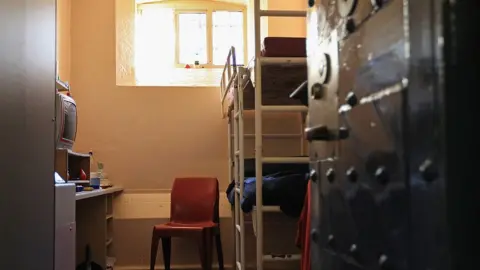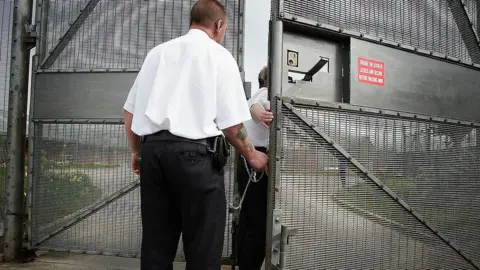Warning over prisoner numbers 'exceeding capacity'
 Getty Images
Getty ImagesThe chief inspector of prisons has said she is "very concerned" that the number of inmates in Scotland is starting to exceed capacity.
The prison population rose by 709 in the year to the end of March, from 7,413 to 8,122.
Wendy Sinclair-Gieben, HM Chief Inspector of Prisons for Scotland, said this 9% increase is equivalent to one additional large prison.
She warned the rise in inmates is putting extra pressure on the system.
In her report for 2018/19, Ms Sinclair-Gieben said planned investment in key infrastructure must not be delayed.
She also called for urgent action to replace HMPs Barlinnie, Greenock and Inverness, saying Victorian prisons are "costly and no longer fit-for-purpose".
Staff pressures
Ms Sinclair-Gieben said: "The additional number of prisoners and an increasingly complex population places a heavy burden on an already overstretched prison service in Scotland.
"I am very concerned that the number of prisoners is starting to exceed design capacity, resulting in not only additional pressures on staff, the prison regime and activities, but also on the essential programme and through-care activities designed to reduce recidivism."
 Getty Images
Getty ImagesScotland's incarceration rate is one of the highest in Europe.
The number of prisoners on remand awaiting trial has also risen from 1,142 last year (15.4% of the prison population) to 1,350 (16.6%) by 31 March this year.
The report said problems relating to overcrowding include:
- Staff having less time to deal with individuals
- Two people sharing cells that have been designed for single occupancy
- Prisoners being located further away from home
- And an "inevitable increase" in the waiting list for offender behaviour programmes.
The "sharp rise" in prisoners has been linked to factors including longer sentences for the most serious of crimes, a rise in the number of people being convicted of sexual offences, and more serious and organised crime being successfully prosecuted.
Other factors include the reduction of prisoners being released on home detention curfew and very few prisoners subject to an order for lifelong restriction achieving parole.
The report said these factors are likely to continue to place pressure on the size of the prison population for some time to come.
 Angela Mudge/Geograph
Angela Mudge/GeographMs Sinclair-Gieben welcomed the Scottish government's plans to extend the presumption against short prison sentences from the current three months to 12.
But she said she remains concerned it "may not be enough to bring the prison population back in line with design capacity".
The report also found the Scottish Prison Service (SPS) is currently facing "immense" financial pressures, with the SPS being obliged to purchase places in the two privately-run prisons in Scotland, HMP Addiewell and HMP Kilmarnock.
Her Majesty's Inspectorate of Prisons for Scotland carried out four full prison inspections, two return visit inspections, five court custody unit (CCU) inspections and two thematic reviews over the year.
Mobility issues
Inspectors noted problems with overcrowding and difficulties with access for people with mobility issues in some CCUs.
They suggested some of the issues could be addressed through greater use of video-link court appearances.
An SPS spokeswoman welcomed the report and said the service "can take pride in how our prisons are run".
She added: "SPS also welcomes HMCIPS's findings that staff and those in our care feel safe, and that they found the relationships and interactions between staff and prisoners to be positive and built on mutual respect.
"We continue to develop the regime for prisoners to maximise the range of purposeful activities available to them such as work, education and offender programmes to address their offending behaviour."
